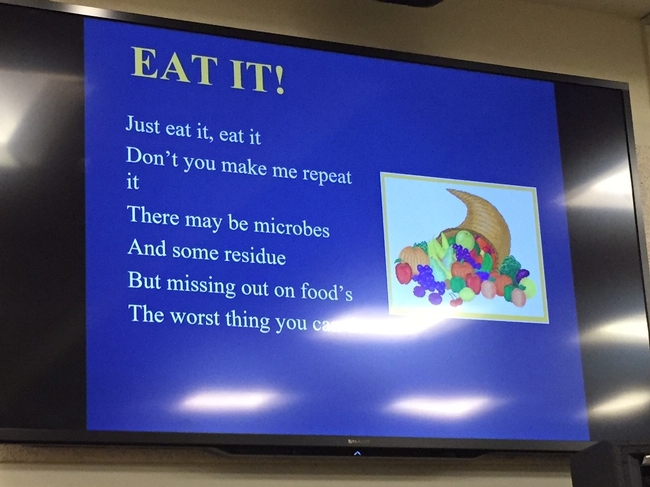I stand corrected; only a couple of SI Leaders pulled together the information for the Federal report. Thanks go out to Cheryl Wilen, Doug Parker, Clare Gupta, Neil McRoberts, David Lile, Chris Greer, and Yana Valachovik for their work! I met with Katherine Webb-Martinez, and we talked about all the many uses for the information provided. It is exciting to think about the opportunities to share your stories and successes.
Now that Cheryl Wilen has rotated off serving as an SI Leader, I don't see her every month for Program Council. She made a special appearance this month to attend a musical performance by Carl Winter, following the Program Council meeting last Tuesday. Carl shared with the Davis ANR building some of his parodies that he developed as a novel method of teaching food safety principles to students. A few years ago, he was awarded a USDA competitive grant to create and deliver the songs. I suspect he may have been disappointed a bit in his stoic audience, but everyone enjoyed the performance and our opportunity to experience both his musical talent and his creativity. We can talk about Mark Bell's dancing in a different post.

Carl's demonstrated his creativity following a Program Council ideation activity. Program Council members worked in small teams to brainstorm ideas that would position UC ANR for the future. Then we slept on it and reconvened on Wednesday to share out our thoughts and think about ‘who would get behind the idea' and ‘what would make the idea work'? The goal wasn't to move forward with the ideas themselves but to get to the development of guiding principles for making decisions going forward. This would include program reviews and resource allocation decisions. It had been a while since the guiding principles had last been reviewed (2009, I think). Like many of the Program Council members, I left thinking as much about the ideas I heard and ‘what if' as I did thinking about the guiding principles. What sunk in with me was that any single idea might be a challenge to implement but the combination of several of the concepts, while identified independently, could come together and forge a path forward. The other thing that stuck out was that those ideas that were the most innovative tended to be the ones that would be the most difficult to implement, often due to internal or external resistance, reinforcing the sentiment that change is hard. Carl commented that one of the challenges he continues to face is that often colleagues don't see him as a serious scientist. And yet, his approach to teaching is not only evidence of his scholarship and creativity, but far more impactful as far as learning and behavior change adoption, than most peer-reviewed journal publications could ever achieve.
